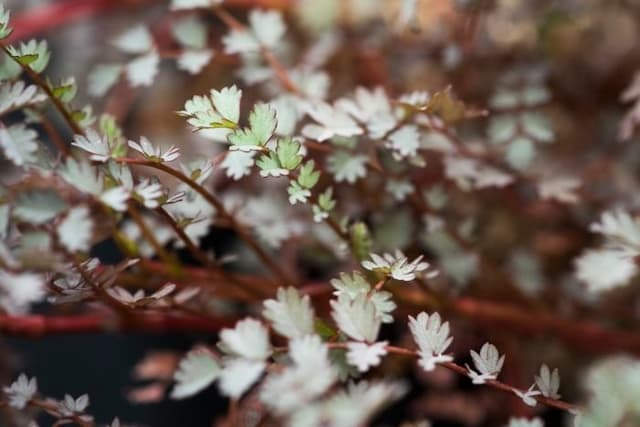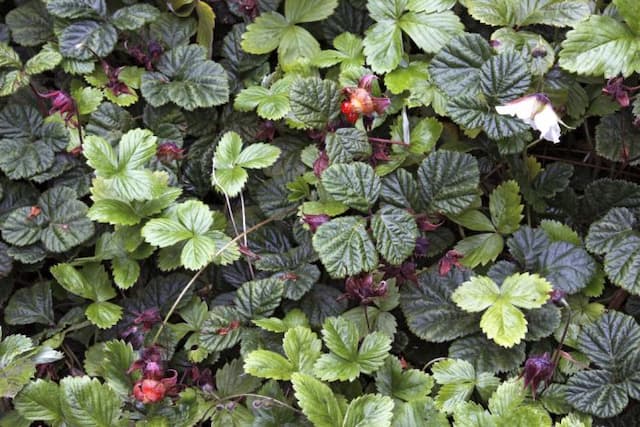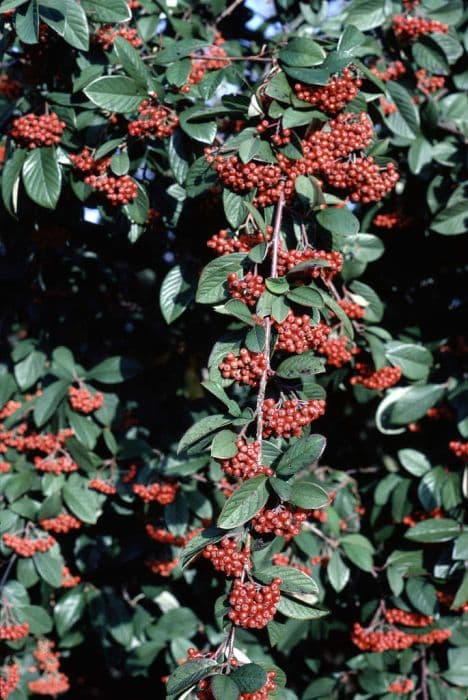Chinese Photinia Photinia serratifolia

ABOUT
Photinia serratifolia, commonly known as Chinese photinia, is a plant distinguished by its broad, evergreen leaves that are glossy and leathery in texture. The leaves have serrated margins, giving them a saw-toothed appearance. Displaying a dark green color on their upper surface, the leaves sometimes emerge with a reddish tinge before maturing to their final hue. As the plant matures through the seasons, it produces showy clusters of small white flowers. These blossoms are quite fragrant and arranged in a structure known as a corymb, which adds a decorative element to the plant's overall appearance. Following the flowering season, the Chinese photinia bears fruits that are small, spherical, and typically red, although they can mature to a darker, almost black color. The overall visual presentation of the Chinese photinia is one of lush foliage complemented by bursts of color from its new growth, flowers, and fruits, which adds a vibrant contrast to its surroundings. The combination of its leafy structure, flowering nature, and fruit production contributes to its popularity in gardens as an ornamental plant.
About this plant
 Names
NamesFamily
Rosaceae
Synonyms
Chinese Photinia, Red Robin, Christmas Berry
Common names
Photinia serrulata, Photinia serratifolia var. serratifolia, Photinia serratifolia var. ardisiifolia, Crataegus serratifolia, Eriobotrya cavaleriei, Photinia ardisiifolia, Stranvaesia serratifolia, Stranvaesia undulata, Photinia glabra, Photinia taiwanensis, Pourthiaea serratifolia.
 Toxicity
ToxicityTo humans
Chinese photinia, when ingested by humans, can potentially be toxic. It contains cyanogenic glycosides, which can release cyanide into the body when digested. The symptoms of poisoning can include nausea, vomiting, abdominal pain, and more severe symptoms such as respiratory distress and an increased heart rate if consumed in large quantities. Ingesting parts of this plant, particularly the berries or leaves, can lead to these toxic reactions, so it is advised to avoid consuming any part of the Chinese photinia.
To pets
In pets, the Chinese photinia can be toxic if ingested. Similar to its effects in humans, it contains compounds that can release cyanide when digested. Symptoms of toxicity in pets may include vomiting, diarrhea, weakness, difficulty breathing, seizures, and potentially coma if consumed in significant amounts. It is particularly dangerous for animals like dogs and cats, and any ingestion of leaves or berries of the Chinese photinia should be treated as a potential poisoning incident, necessitating immediate veterinary attention.
 Characteristics
CharacteristicsLife cycle
Perennials
Foliage type
Evergreen
Color of leaves
Green
Flower color
White
Height
10-15 feet (3-4.5 meters)
Spread
6-10 feet (1.8-3 meters)
Plant type
Shrub
Hardiness zones
7-9
Native area
China
Benefits
 General Benefits
General Benefits- Ornamental Value: Photinia serratifolia, commonly known as Chinese Photinia, features attractive glossy leaves and bright red young foliage, making it a popular choice for decorative hedging and landscaping.
- Privacy Screen: With its dense foliage, Chinese Photinia provides an excellent natural privacy screen for gardens and backyards, blocking out unwanted views and creating a sense of seclusion.
- Low Maintenance: Chinese Photinia is relatively low maintenance, requiring minimal pruning and care once established, which makes it suitable for both amateur and experienced gardeners.
- Drought Tolerance: Once established, the plant has a good level of drought tolerance, making it suitable for regions with occasional water scarcity.
- Pest Resistance: It has a degree of resistance to common garden pests, reducing the need for chemical pest control measures.
- Adaptability: The plant can adapt to a range of soil types, though it prefers well-drained conditions, making it versatile for different gardening scenarios.
- Fast Growth: Chinese Photinia has a fast growth rate which makes it ideal for quickly establishing a hedge or filling in landscape areas.
- Wildlife Attraction: The small white flowers that bloom in the spring can attract a variety of pollinators, while the red berries that follow can be a food source for birds.
- Seasonal Interest: With changing leaf colors throughout the seasons—from bright red in new growth to dark green in maturity—Chinese Photinia offers year-round visual interest.
- Soil Erosion Control: Its root system can help to stabilize soil and prevent erosion on slopes and in other vulnerable areas.
 Medical Properties
Medical Properties- This plant is not used for medical purposes.
 Air-purifying Qualities
Air-purifying QualitiesThis plant is not specifically known for air purifying qualities.
 Other Uses
Other Uses- Photinia serratifolia, commonly known as Chinese photinia, can be used as a natural dye, with its leaves providing a range of colors for fabrics or crafts depending on the mordant used.
- The wood of Chinese photinia is sometimes utilized in the creation of small wooden objects such as handles, intricate carvings or in woodturning projects due to its workable nature.
- Dense hedges of Chinese photinia can provide privacy screens or windbreaks in garden and landscape design, taking advantage of its rapid growth and thick foliage.
- Chinese photinia's vibrant red young leaves can be used in floral arrangements as an interesting and colorful foliage filler.
- The plant can be incorporated into bonsai art, with its attractive leaves and ability to respond well to pruning making it suitable for creating miniature tree designs.
- The robust branches of Chinese photinia can serve as natural supports for climbing plants or vines in a mixed garden setting.
- Leaves of the Chinese photinia can be scattered among books or linens to impart a subtle fragrance and to deter pests like silverfish and moths.
- Dried branches and foliage of Chinese photinia may be used in crafting seasonal wreaths and other decorative items, especially in the fall when leaf color is most vibrant.
- The dense canopy of Chinese photinia can be used as sound barriers in urban gardens to reduce noise pollution.
- When pruned correctly, Chinese photinia can be used as topiary plants, sculpted into various formal shapes and designs for ornamental purposes.
Interesting Facts
 Feng Shui
Feng ShuiThe Chinese Photinia is not used in Feng Shui practice.
 Zodiac Sign Compitability
Zodiac Sign CompitabilityThe Chinese Photinia is not used in astrology practice.
 Plant Symbolism
Plant Symbolism- Growth: Photinia serratifolia, commonly known as Chinese Photinia, often symbolizes growth due to its rapid development and lush foliage, representing personal or spiritual expansion.
- Renewal: The plant's propensity to regenerate after trimming or adverse conditions signifies renewal and the ability to bounce back from challenges.
- Protection: With its dense growth habit and evergreen nature, Chinese Photinia can represent protection, providing a natural shelter and privacy screen in gardens.
- Transformation: As Chinese Photinia features new red growth that transforms to green with maturity, it symbolizes transformation and the beauty in change.
- Adaptability: Given the plant's versatility and its adaptability to different environments, it represents the ability to thrive in diverse conditions and situations.
 Water
WaterFor Chinese Photinia, it is essential to maintain consistent moisture, especially during the first growing season to establish a deep, extensive root system. Watering should be done deeply, providing about 1-2 gallons per plant once a week during its first year. After establishment, reduce frequency, but be mindful to increase it during prolonged dry spells or extreme heat. Ample water is critical to ensure the plant does not suffer from drought stress. Emphasize deep watering rather than frequent shallow sprinklings, allowing soil to dry slightly between watering intervals.
 Light
LightChinese Photinia thrives in full sun to partial shade. The ideal spot would allow for at least six hours of direct sunlight daily, but it can also tolerate a bit of shade, particularly in the hotter part of the day. Avoid deep shade locations, as this can hamper the plant's growth and lead to fewer vibrant red leaves, which are a desirable feature of this species.
 Temperature
TemperatureChinese Photinia is adaptable to a range of temperature conditions and can withstand a temperature as low as 10 degrees Fahrenheit during winter months. Ideally, temperatures should remain between 60 and 80 degrees Fahrenheit for optimal growth. However, it's known for its hardiness and can survive brief periods of extremes above and below this range, although prolonged exposure can be damaging.
 Pruning
PruningPruning Chinese Photinia helps maintain its desired shape, removes any damaged or diseased branches, and encourages new growth. Pruning should be done in late winter or early spring before new growth starts. For shaping and size control, prune annually; for rejuvenation of older plants, more extensive pruning may be required. Always cut above a leaf node to encourage healthy new shoots. The best time for pruning is when the plant is dormant.
 Cleaning
CleaningAs needed
 Soil
SoilChinese Photinia thrives in well-draining, loamy soil with a slightly acidic to neutral pH, ranging from 6.0 to 7.5. For optimal growth, a mix of two parts garden soil, one part peat moss, and one part perlite or sand can create the ideal environment for its roots.
 Repotting
RepottingChinese Photinia does not need frequent repotting and generally prefers to be slightly root-bound. Repot the plant every 2-3 years to replenish the soil and provide space for root growth.
 Humidity & Misting
Humidity & MistingChinese Photinia is adaptable to a range of humidity levels but prefers moderate humidity. Strive for around 40-50% relative humidity for optimal plant health.
 Suitable locations
Suitable locationsIndoor
Provide bright indirect light, well-draining soil, and moderate watering.
Outdoor
Plant in partial shade or full sun, well-draining soil; water regularly.
Hardiness zone
7-11 USDA
 Life cycle
Life cyclePhotinia serratifolia, commonly known as Chinese photinia, begins its life cycle when a seed germinates in the spring, requiring moist, well-drained soil and adequate warmth. The seedling stage follows, where the plant develops its first leaves and a root system which takes a few years. During the juvenile stage, the plant continues to grow rapidly, establishing a strong stem and branch structure and is characterized by larger leaves and the absence of flowers. When the plant reaches maturity after several years, it enters the flowering stage, producing small, white flowers in clusters that are often followed by red to dark purple fruits if pollinated. After the flowering stage, Chinese photinia enters a phase of vegetative growth and maintenance where it will grow and produce flowers annually. The lifespan of the plant can span several decades, concluding with senescence where growth slows, foliage becomes sparse, and the plant eventually dies.
 Propogation
PropogationPropogation time
Spring-Early Summer
The most popular method of propagating Chinese Photinia, Photinia serratifolia, is done through semi-hardwood cuttings. This process is usually performed in the late summer after new growth has matured and slightly toughened. To propagate from cuttings, one must select healthy stems with several leaves and cut them to a length of about 6 to 8 inches (15 to 20 centimeters). The lower leaves are removed, and the cut end is often treated with a rooting hormone to encourage root development. The cutting is then planted in a mixture of potting soil and perlite, ensuring a warm and moist environment to facilitate root growth. Adequate humidity is maintained by covering the cutting with a plastic dome or bag, and it's essential to keep the soil consistently moist, for the cutting to root successfully in a few weeks.


![Indian hawthorn [Enchantress]](/_next/image?url=https%3A%2F%2Fplants-admin.emdemapps.com%2Fimages%2Fplants%2F%2Fimages%2F604b5eefbd4f1.png&w=640&q=75)






